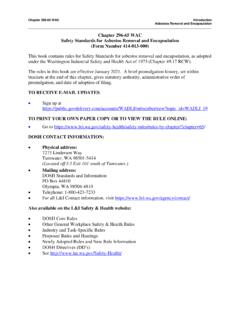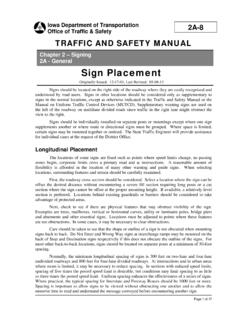Transcription of U.S.LEGAL SYSTEM U.S.LEGAL SYSTEMOUTLINE OF THE …
1 O. OUUT. TLLIIN. NEE O. OFF T. THHE. E. SYSTEM . outline OF THE. SYSTEM . Bureau of International Information Programs United States Department of State 2004. outline OF THE. SYSTEM . C O N T E N T S. INTRODUCTION. The legal SYSTEM .. 4. chapter 1. History and Organization of the Federal Judicial SYSTEM .. 18. chapter 2. History and Organization of State Judicial Systems .. 44. chapter 3. Jurisdiction and Policy-Making Boundaries .. 56. chapter 4. Lawyers, Litigants, and Interest Groups in the Judicial Process .. 72. chapter 5. The Criminal Court Process .. 90. chapter 6. The Civil Court Process .. 118. chapter 7. Federal Judges .. 140. chapter 8. Implementation and Impact of Judicial Policies .. 158. The Constitution of the United States .. 177. Amendments to the Constitution of the United States .. 192. Glossary .. 204. Bibliography .. 212. Index .. 214. INTRODUCTION. THE. legal . SYSTEM . In this scene from an 1856. painting by Junius Brutus Searns, George Washington (standing, right) addresses the Constitutional Convention, whose members drafted and signed the Constitution on September 17, 1787.
2 The Constitution is the primary source of law in the United States. 6 outline OF THE legal SYSTEM . Every business day, courts throughout the predictability and enforceable the United States render decisions that common norms that the rule of law together affect many thousands of provides and the legal SYSTEM people. Some affect only the parties to guarantees. a particular legal action, but others ad- This introduction seeks to familiar- judicate rights, benefits, and legal ize readers with the basic structure principles that have an impact on vir- and vocabulary of American law. tually all Americans. Inevitably, many Subsequent chapters add detail, and Americans may welcome a given rul- afford a sense of how the legal ing while others sometimes many SYSTEM has evolved to meet the others disapprove. All, however, ac- needs of a growing nation and its cept the legitimacy of these decisions, ever more complex economic and and of the courts' role as final inter- social realities.
3 Preter of the law. There can be no more potent demonstration of the trust that Americans place in the rule A FEDERAL legal SYSTEM : of law and their con dence in the Overview legal SYSTEM . he American legal SYSTEM has The pages that follow survey that SYSTEM . Much of the discussion ex- plains how courts are organized T several layers, more possibly than in most other nations. One reason is the division between and how they work. Courts are central federal and state law. To understand to the legal SYSTEM , but they are not this, it helps to recall that the United the entire SYSTEM . Every day across States was founded not as one nation, America, federal, state, and local but as a union of 13 colonies, each courts interpret laws, adjudicate dis- claiming independence from the putes under laws, and at times even British Crown. The Declaration of strike down laws as violating the fun- Independence (1776) thus spoke of damental protections that the Consti- the good People of these Colonies.
4 Tution guarantees all Americans. At but also pronounced that these the same time, millions of Americans United Colonies are, and of Right transact their day-to-day affairs with- ought to be, FREE AND INDEPEN- out turning to the courts. They, too, DENT STATES. The tension between rely upon the legal SYSTEM . The young one people and several states is a couple purchasing their rst home, perennial theme in American legal two businessmen entering into a con- history. As explained below, the tract, parents drawing up a will to pro- Constitution (adopted 1787, rati ed vide for their children all require 1788) began a gradual and at times INTRODUCTION 7. hotly contested shift of power and SOURCES OF FEDERAL LAW. legal authority away from the states and toward the federal government. The United States Constitution Still, even today states retain substan- tial authority. Any student of the Supremacy of Federal Law American legal SYSTEM must under- uring the period 1781 88, an stand how jurisdiction is apportioned between the federal government and the states.
5 D agreement called the Articles of Confederation governed relations among the 13 states. It estab- The Constitution xed many of the lished a weak national Congress and boundaries between federal and state left most authority with the states. The law. It also divided federal power Articles made no provision for a feder- among legislative, executive, and judi- al judiciary, save a maritime court, al- cial branches of government (thus though each state was enjoined to creating a separation of powers honor (afford full faith and credit . between each branch and enshrining to) the rulings of the others' courts. a SYSTEM of checks-and-balances The drafting and rati cation of to prevent any one branch from the Constitution re ected a growing overwhelming the others), each of consensus that the federal government which contributes distinctively to the needed to be strengthened. The legal legal SYSTEM . Within that SYSTEM , the SYSTEM was one of the areas where Constitution delineated the kinds of this was done.
6 Most signi cant was laws that Congress might pass. the supremacy clause, found in As if this were not suf ciently com- Article VI: plex, law is more than the statutes This Constitution, and the Laws of passed by Congress. In some areas, the United States which shall be Congress authorizes administrative made in Pursuance thereof; and all agencies to adopt rules that add detail Treaties made, or which shall be to statutory requirements. And the made, under the Authority of the entire SYSTEM rests upon the tradition- United States, shall be the supreme al legal principles found in English Law of the Land; and the Judges in Common Law. Although both the every State shall be bound thereby, Constitution and statutory law super- any Thing in the Constitution or sede common law, courts continue Laws of any State to the Contrary to apply unwritten common law notwithstanding. principles to ll in the gaps where the Constitution is silent and Congress This paragraph established the rst has not legislated.
7 Principle of American law: Where the 8 outline OF THE legal SYSTEM . federal Constitution speaks, no state branches. As James Madison explained may contradict it. Left unclear was in Federalist No. 51, usurpations are how this prohibition might apply to guarded against by a division of the the federal government itself, and the government into distinct and separate role of the individual state legal sys- departments. Each of Madison's de- tems in areas not expressly addressed partments, legislative, executive, and by the new Constitution. Amend- judiciary, received a measure of ments would supply part of the an- in uence over the legal SYSTEM . swer, history still more, but even today Americans continue to wrestle with Legislative the precise demarcations between the The Constitution vests in Congress the federal and state domains. power to pass legislation. A proposal considered by Congress is called a bill. Each Branch Plays a Role in the If a majority of each house of Con- legal SYSTEM gress two-thirds should the Presi- While the drafters of the Constitution dent veto it votes to adopt a bill, it sought to strengthen the federal gov- becomes law.
8 Federal laws are known ernment, they feared strengthening it as statutes. The United States Code is a too much. One means of restraining codi cation of federal statutory law. the new regime was to divide it into The Code is not itself a law, it merely The Constitution has vested the power to pass legislation in Congress, here gathered in a joint session for President George W. Bush's budget speech in 2001. The executive power, in turn, is entrusted to the President. INTRODUCTION 9. presents the statutes in a logical quite speci c but others, most notably, arrangement. Title 20, for instance, To regulate Commerce with foreign contains the various statutes pertain- Nations, and among the several States, . ing to Education, and Title 22 those are less so. Obviously the power to in- covering Foreign Relations. terpret the less precise delegations is Congress' lawmaking power is lim- extremely important. Early in the ited. More precisely, it is delegated by young republic's history, the judiciary the American people through the branch assumed this role and thus se- Constitution, which speci es areas cured an additional and extremely where Congress may or may not legis- vital role in the legal SYSTEM .
9 Late. Article I, Section 9 of the Consti- tution forbids Congress from passing Judicial certain types of laws. Congress may As with the other branches, the not, for instance, pass an ex post facto judiciary possesses only those powers law (a law that applies retroactively, or the Constitution delegates. The Con- after the fact ), or levy a tax on ex- stitution extended federal jurisdiction ports. Article I, Section 8 lists areas only to certain kinds of disputes. Arti- where Congress may legislate. Some of cle III, Section 2 lists them. Two of the these ( To establish Post Of ces ) are most signi cant are cases involving a question of federal law ( all Cases in Law and Equity, arising under this Constitution, the Laws of the United States, and Treaties made ) and di- versity cases, or disputes between cit- izens of two different states. Diversity jurisdiction allows each party to avoid litigating his case before the courts of his adversary's state.
10 A second judicial power emerged in the Republic's early years. As explained in chapter 2, the Supreme Court in the case of Marbury v. Madison (1803) interpreted its delegated pow- ers to include the authority to deter- mine whether a statute violated the Laws passed by one of the 50 state Constitution and, if it did, to declare legislatures, such as the New York State such a law invalid. A law may be un- Assembly shown above during a roll call, apply only to the citizens of that state or constitutional because it violates rights outsiders who reside or do business there. guaranteed to the people by the Con- 10 outline OF THE legal SYSTEM . stitution, or because Article I did not executive branch consisted of the authorize Congress to pass that kind President, Vice President, and the of legislation. Departments of State, Treasury, War, The power to interpret the consti- and Justice. As the nation grew, the ex- tutional provisions that describe ecutive branch grew with it.




